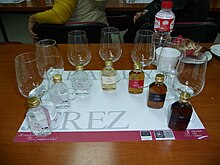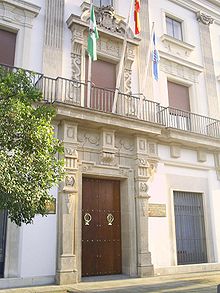|
Brandy de Jerez  Brandy de Jerez is a brandy that is matured in a solera system in the Jerez area of Andalusia, Spain.[2] Besides being sold as a brandy, it is also an ingredient of some sherries. It has a Protected Designation of Origin (PDO), being matured exclusively within the "Sherry Triangle", the municipal boundaries of Jerez de la Frontera, El Puerto de Santa María and Sanlúcar de Barrameda, in the province of Cádiz. HistoryBeing unable to drink the already famous wines to be found in the Jerez region for religious reasons, the Moors opted to distil them in order to obtain “alcohol” not only to make perfumes but also for antiseptic and medicinal use. When wine spirits began to be aged in oak-wood casks in order to produce brandy is unknown. However, by the sixteenth century sufficient wine spirit was being produced that levies on its manufacture could be dedicated to public works, as in the Town Council of Jerez handing over the revenue from its municipal Wine Spirit Tax to the Church in 1580 for the construction of a Jesuit college. The eighteenth and nineteenth centuries saw the consolidation in Spain of the production of wine spirit for commercial use destined for exportation, especially to countries in Northern Europe. The Netherlands were the main market and from there shipped on to practically the whole world. Brandy is an English adaptation of the original Dutch word “brandewijn” (burnt wine) whilst the term holanda (name given to wine spirits of low alcoholic content used in the production of Brandy de Jerez) is derived from the name of the country to which most of the exports were destined: Holland. The term 'brandavin' was already in use in picaresque literature of the 17th Century, as can be seen in “The Life and Works of Estebanillo González, man of good humour”. In the early 19th century English and French merchants began to arrive in Jerez and, together with Spanish traders with clear commercial instincts, promoted trade and laid down the guidelines for the characteristic production and ageing process of Brandy de Jerez. The creation of brand names for Brandy de Jerez occurred during the 19th Century on the initiative of sherry firms who were pioneers in the sale of brands which still exist today, not only in Spain but in numerous countries throughout the world. Production Brandy de Jerez uses two different types of distillation equipment, both made of copper:[3]
In the case of Brandy de Jerez double distillation is not required. From a simple distillation wine spirits of 65% by volume are obtained. The more a wine is distilled, the more of its characteristics and aromatic substances are lost. The traditional production method of Brandy de Jerez is controlled by the Consejo Regulador del Brandy de Jerez (the Brandy de Jerez Regulatory Council). The method has three main characteristics:
In Jerez it is also possible to use wine spirits of a higher degree of alcoholic content, but never (by decree of the Consejo) more than 50% of the total. The holandas must always represent 50% minimum of the final brandy. Classification of Brandy de Jerez The Brandy de Jerez Regulatory Council classifies brandy de Jerez according to age:
Tourism"Enotourism" is a quite new kind of tourism that looks for places where wines and distilled beverages are produced. Recently the Route of Sherry Wine and Brandy de Jerez has been established.[6] Brandy de Jerez in Spanish cuisineBrandy de Jerez is being used in Spanish cuisine in recent years, especially with meats.[7] References
Wikimedia Commons has media related to Brandy de Jerez. External links
|